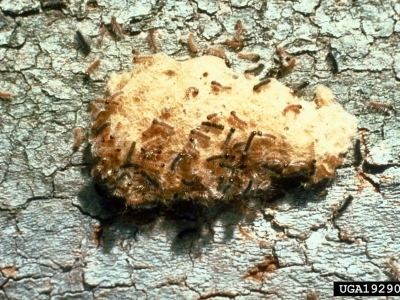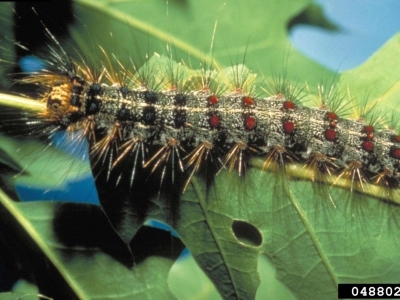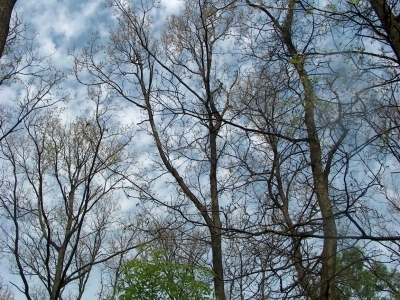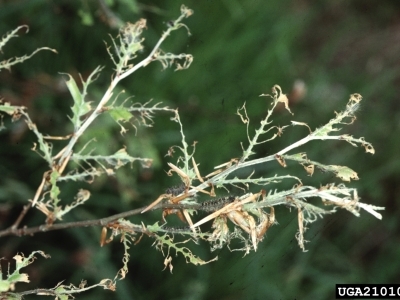Spongy Moth

E. Bradford Walker, Vermont Department of Forests, Parks and Recreation, Bugwood.org
Spongy moth (Lymantria dispar dispar) is a destructive, invasive insect that poses a danger to North America's forests. The caterpillars feed on the leaves of more than 300 species of trees and shrubs, eventually killing them. Female moths lay eggs on many outdoor surfaces—stacked firewood, trailers, grills, lawn furniture, and toys. When people move these items to a new location, the spongy moth's eggs also move.
Native to Europe, the spongy moth first arrived in the United States well over a century ago. Today it can be found throughout the Northeastern United States where it has dramatically changed the landscape. Early detection is critical to limit the spongy moth's spread to new areas. If left unchecked, this pest can strip leaves and even kill trees, if severe defoliation persists for multiple seasons.
- Egg masses (late summer, winter and spring)
- Female moths attach egg masses to trees, stones, walls, logs, and household items, such as patio furniture, children’s toys, and lawn equipment.
- Each egg mass contains up to 1,000 eggs and is covered with buff or yellowish “hair” (from the abdomen of the female).
- Egg masses are about 1-1/2 inches long and 3/4-inch wide on average.
- Caterpillars (spring)
- Newly hatched caterpillars are black and hairy.
- Older caterpillars are a mottled yellow to gray color with tufts of bristle-like hairs. They also have a distinctive color pattern along their backs with five pairs of blue dots followed by six pairs of red dots.
- They are about 1-1/2 to 2-1/2 inches long when fully grown.
- Adult moths (summer)
- Male moths are brown with a darker brown pattern on their wings and have a 1-1/2-inch wingspan.
- Females are nearly white, slightly larger, and have a 2-inch wingspan but do not fly. Their wings are marked with dark, saw-toothed patterns.
- Defoliated trees
- Infested trees may be partially or completely bare of leaves.
- A heavily infested forest will have a barren, wintry look in the middle of the summer.
View photos of spongy moth and the damage it causes:







1st instar larva emerging from egg mass. USDA Photo.
Spongy Moth Pupae. Photo by PA Department of Conservation and Natural Resources-Forestry Archive, Bugwood.org
Spongy Moth Larva. USDA Photo by John H. Ghent, Forest Service, Bugwood.org
Female spongy moths laying egg masses. Photo by Milan Pernek, Forestry Research Institute, Bugwood.org
Defoliation, Photo by Haruta Ovidiu, University of Oradea, Bugwood.org
Defoliated oak branch, Photo by Louis-Michel Nageleisen, Département de la Santé des Forêts, Bugwood.org
Adult Male Spongy Moth, USDA Photo by John H. Ghent, Forest Service
The spongy moth is a hitchhiker. People can unknowingly spread this pest when they move vehicles and other outdoor items that have spongy moth egg masses attached. Here's what you can do to prevent spongy moth from spreading:
- Look for spongy moth egg masses on trees, lawn furniture, fences, walls, outdoor items, and report them to Federal or State agriculture officials if you are not in a quarantine area.
- Know and follow any quarantines regulations in your area, especially if you are relocating. Check the Regulatory Information panel below for more information.
- Before moving or traveling out of an infested area, check for the spongy moth egg masses, caterpillars and adults. This is required by Federal law in many areas. See details below under "Your Move Spongy Moth-Free."
- Buy local firewood and burn it on site. Do not move firewood.
- Comply with Federal, State, and local spongy moth restrictions.
- Cooperate with agriculture officials surveying for this pest. They may ask for access to your property to place and check insect-monitoring traps.
Your Move Spongy Moth-Free
Per USDA requirements, you must inspect and remove spongy moth egg masses from household goods before moving from a location within a spongy moth quarantine area to a location outside the quarantine area.
You may face penalties if you are required to inspect but fail to do so. Fortunately, it's easy to meet the requirements:
- Check the map to find out whether you live in a quarantine area.
- Look for spongy moth egg masses and other life stages (see above photos) on all outdoor household items.
- Use and print the self-inspection checklist (2.85 MB) or the online checklist option.
- If you're moving between April and August, complete the inspection on moving day, if possible.
- If you cannot complete the inspection on moving day, you must protect the items from infestation. Seal them under a tarp or keep them indoors or in a closed moving truck.
- Remove and destroy any egg masses or life stages you find.
- Scrape them off with a putty knife, stiff brush, or similar hand tool.
- Dispose of egg masses and other life stages in a container of hot, soapy water, or place them in a plastic bag, seal it, and set it in the sun.
- Check each item off on your checklist (2.85 MB) as you go and complete the requested information.
- If a qualified certified applicator performs the inspection, be sure you get a copy of the completed, signed checklist.
- Keep a copy of the completed checklist in the vehicle moving the goods. This is your official certificate of inspection. USDA or State officials may request it during your trip.
- If you are not driving, provide a copy to the driver.
- If you are not driving, provide a copy to the driver.
Note: If you do not live in a quarantine area, this law does not apply to you.
Questions? Contact your State plant regulatory official or State plant health director.
Homeowners in spongy moth quarantine areas can contact their county Extension office to ask about spongy moth control options. Individuals in non-quarantine areas, should contact their State plant health director or State plant regulatory official to report spongy moth.
Report Plant Pests and Diseases
Have you seen this pest or signs of pest damage? Immediately report your findings.
Find your State plant regulatory official
Find your State plant health director
Controlling Spongy Moth
Spongy moth is currently found in Connecticut, Delaware, the District of Columbia, Illinois, Indiana, Maine, Maryland, Massachusetts, Michigan, Minnesota, New Hampshire, New Jersey, New York, North Carolina, Ohio, Pennsylvania, Rhode Island, Vermont, Virginia, West Virginia, and Wisconsin.
Host trees are everywhere, and all States are at high risk for spongy moth. People can spread the pest when they move regulated articles (134.24 KB), such as patio furniture, lawn equipment, outdoor play toys, grills, trailers, and vehicles, from the quarantine area.
Through quarantines and an active regulatory program, APHIS works with State departments of agriculture, U.S. Forest Service, and other cooperators to define the extent of the spongy moth infestation, eradicate isolated populations, and regulate the human-assisted spread of the pest beyond the infested area. Our effective partnerships have successfully limited the spread of spongy moth.
- Spongy Moth Regulated Areas (171.41 KB)
- Spongy Moth Regulated Articles (134.24 KB)
Code of Federal Regulations
Federal Orders
- August 8, 2023, APHIS Adds Lake and Whitley Counties, Indiana to the Spongy Moth (Lymantria dispar) Quarantine Area (171.68 KB)
- April 10, 2023, APHIS Adds Douglas County, Wisconsin to the Spongy Moth (Lymantria dispar) Quarantine Area (144.95 KB)
- May 28, 2014, APHIS Removes a Condition of Movement for Certain Articles Regulated for Gypsy Moth (19.27 KB)
(Lymantria dispar asiatica, L. d. japonica, L. albescens, L. umbrosa, and L. postalba)
The life stages of the flighted spongy moth complex (FSMC) look and behave almost identically to spongy moth life stages. One difference is that FSMC adult females can fly and spread rapidly if left unchecked. Also, this pest is not established in the United States.
We periodically detect these pests on ships arriving at U.S. ports from countries where they are known to occur. Their egg masses tolerate temperature and moisture, and travel well on the hulls and rigging of ocean-going ships, shipping containers, and pallets.
To mitigate the pest risk, APHIS and the Canadian Food Inspection Agency (CFIA) work with China, Japan, South Korea, and Russia to inspect and certify that ships headed for North America are free of flighted spongy moth complex before they leave Asia. When ships arrive here, APHIS inspects them for flighted spongy moth complex. We also periodically survey general and high-risk areas to detect any possible introductions in the United States.
If we confirm a flighted spongy moth complex detection in the United States, we will work with other Federal and State agencies to evaluate the infestation and take actions to eradicate the pest.
- Flighted Spongy Moth Complex Survey and Response Guidelines (1.12 MB)
USDA has created a number of outreach materials to help its partners, which include moving companies and associations, environmental groups and advocates, and government agencies, to spread the word about the spongy moth. With this toolkit, our partners can reach out to people moving or traveling out of an infested area and explain the steps they can take to protect America's forests and comply with Federal law. The partner toolkit elements are free and can be downloaded with the links below.
- Distribute or post a link to our checklist “It's the Law: Before Moving, Check for the Spongy Moth” (3.6 MB).
- Provide the list of quarantined counties (171.41 KB) to their customers or stakeholder.








